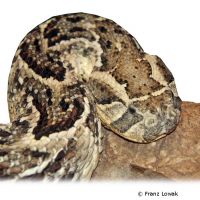Puff Adder (Bitis arietans)
| Puff Adder Bitis arietans | |
|---|---|
| Name | Puff Adder |
| Name Lat. | Bitis arietans |
| Family | Vipers |
| Family lat. | Viperidae |
| Order | Scaled Reptiles |
| Order lat. | Squamata |
| Origin | Africa |
| Habitat | Shrub savanna |
| Diet | Small mammals |
| Humidity | 50-70 % |
| Behavior | Nocturnal; semi-aggressive |
| Keeping | Individual, pair, group |
| Care Level | Experts only |
| Reproduction | Ovoviviparous |
| Housing | Semi-humid terrarium |
| Life Span | 10-15 years |
| Protection | No |
| Metric Units | |
| Size | 80-120 cm |
| Temperature | 25-30 °C |
| Temperature Local | 30-35 °C |
| Housing Size | 150 x 80 x 80 cm |
| US Units | |
| Size | 31"-47" |
| Temperature | 77-86 °F |
| Temperature Local | 86-95 °F |
| Housing Size | 60" x 30" x 30" |
Distribution and habitat
The distribution area of the crepuscular and nocturnal puff adders is the entire African continent with the exception of the inner Sahara and the central rainforest areas. They live well camouflaged during the day in the high grass of the bush or under stones.
Maintenance
Minimum dimensions for the terrarium, according to the size and number of animals:
| 1-2 animals | 1KL x 0,5KL x 0,5KL (L x W x H) |
Body length (KL) is measured on the largest animal. For each additional animal the floor space should be increased by 20%. A terrarium of e.g. L 150 x W 80 x H 80 cm is recommended, which should be placed in a quiet and vibration-free place
They need a terrarium structured with coarse stones and roots (hiding places and visual protection), especially escape-proof, with a loose substrate, e.g. of sand or sand-peat mixture with a layer of dry foliage, as well as an easy-to-clean water basin as drinking and bathing possibility. Each animal requires a basking spot warmed by radiators. Once a day, preferably in the evening, the inside of the terrarium should be sprayed with water in such a way that the bottom can dry off quickly (no waterlogging).
| Temp. day: 25-30 °C | Temp. night: 18-22 °C | Temp. local: up to 35 °C | Humidity: 50-70 |
Thermostatically controlled floor heating is recommended. Lighting duration must be 12-14 hrs depending on the season. Daylight fluorescent tubes supplemented with spotlights are ideal.
Diet
According to their size, the food supply consists mainly of live rodents (mice, rats, etc.) as well as nestlings and small pigeons. After successful acclimation, the changeover to dead food animals (commercially available frozen food) is often successful. Young animals should be offered food up to three times a week, adults once a week. If the snake is disturbed after feeding, this can lead to vomiting of the prey. It is better to offer several small feeders, rather than one large one. If it does not eat for a long period of time, both the timing and the food should be varied. It is important to fortify the food animals with vitamins and minerals. Since the snake could be injured by live rodents, it should not be left unattended with them.
Reproduction and breeding
Probing by the veterinarian is the only reliable method of sex determination
They are viviparous (ovoviviparous). The gestation period is 4-6 months, and the fully developed 30-80 young are 15-25 cm long. Life expectancy can be 10-15 years.
Obligation to report
Be sure to find out about any bans on keeping or permits to keep dangerous animals in your state or municipality (e.g. Ordnungsamt). Your pet store will be happy to provide you with further information.
Important
The puff adder is responsible for most venomous snake bites in Africa. It is not aggressive, but strikes in a flash when it feels threatened or disturbed. Its venomous fangs are very long and the bite injects large amounts of a cytotoxic venom that is very painful and causes significant tissue destruction. The bite can cause death within a few hours under unfavorable circumstances
For the dormancy period, for 1-3 months the illumination time is reduced by 2-4 hours and the temperature is lowered by 3-4 °C, depending on the origin.
When handling, a snake hook or snake forceps and protective gloves are essential.
The terrarium must have good ventilation without drafts and meet the species specific needs. Measuring devices such as thermometers, hygrometers, etc. are necessary. The lighting has to correspond to the species-specific day-night rhythm and has to be placed in such a way that the animals cannot injure themselves. The terrarium should be locked in such a way that neither unauthorized persons can open it nor the animals can escape. Contamination must be removed regularly.
Further literature can be found in your pet store.
References
Text: Christian Sänger; Image: Franz Lowak
Source: BMELV (1997): Tierschutzgutachten - Mindestanforderungen an die Haltung von Reptilien; ENGELMANN (2006): Zootierhaltung - Tiere in menschlicher Obhut: Reptilien und Amphibien, Harri Deutsch Verlag
- Gemäß § 21 Abs. 5 Tierschutzgesetz idgF
